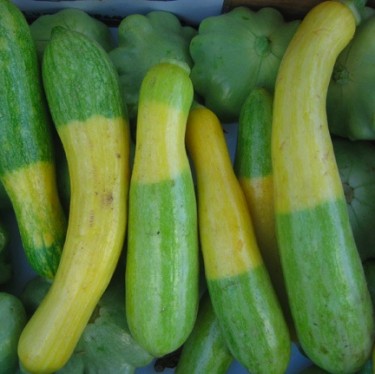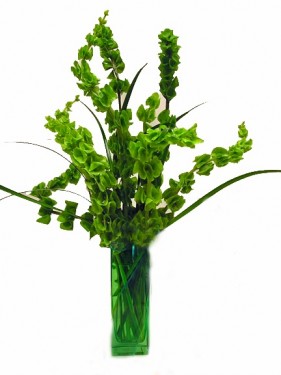This past season was pretty hard on tomatoes. Lots of rain, cool temperatures, and very high disease pressure made for less than ideal conditions. At Red Wagon, we grow varieties that taste really good and that produce well. Sometimes those two things don't always go together, and flavor is sacrificed for high yields, or the other way around. Our tomato variety list has always favored flavor; in other words, we grow lots of open-pollinated, heirloom varieties that don't always produce high yields, but whose flavor is far superior to those hard lobes lurking on grocery store shelves. All of the 'heirloom' varieties you see in catalogs or in our plant displays have stopped being commercially produced by large farms, and while enjoying a renaissance among small, local and organic farms, their lack of shipability (too delicate) and irregular shapes and sizes will likely make sure they remain a stranger to the tractor trailer.
For the sake of clarity, let me explain something about the language used to describe plant varieties. 'Heirloom' and 'hybrid' are not exactly parallel terms. Their is no botanical definition of an 'heirloom' - that is just a folksy way of saying a certain variety has been around a long time, it is open pollinated (more on that in a second) and there is often some sort of story associated with how the seed has been saved over many generations. The heirlooms often taste better--but not always--and sometimes the propaganda around an heirloom's attributes eclipses the reality. A hybrid variety is a plant that has been bred from two different tomato varieties. This gives it, in theory, hybrid vigor. For example, one parent is known for its resistance to pathogens but has the mouth-feel of a doorknob while the other parent is famous for flavor, but withers at the sight of a fungal spore. A hybrid variety is bred with a higher degree of human intervention, than an open pollinated variety. This simple plant breeding has been going on since the beginning of agriculture and is not to be confused with recombinant DNA breeding which is inter-specific (think fish genes in a tomato). Open-pollinated varieties are plants with the same exact parents and are bred with the simple aid of wind, insect, or plant mechanics--i.e. humans don't have to get involved other than to isolate the plants from other varieties, and to collect the seed etc. All 'heirloom' varieties are open-pollinated, but again, remember that 'heirloom' is not a scientific term, it's more of a literary term - think "plants with stories."
A while back, a New York Times editorial by chef and restauranteur, Dan Barber, confirmed what I had been thinking: that in order for our agriculture-and on a small scale, our back yard gardens-to thrive, we need to diversify. This past summer, those gardens that included a mix of heirloom tomatoes and hybridized tomatoes probably had better luck over all. I know that in my garden, that was true, but I was still a little surprised that the margin between the two was pretty slim. In spite of the harsh conditions, my tomatoes did pretty well. I gave them lots of mulch and lots of space between the plants and I regularly clipped off yellowing vegetation. Surprisingly, some of the hybrids died really early on (they are bred for resistance to certain pathogens, but not all), and some of the heirlooms clung on for dear life until our first (very early) frost. So the lesson I learned is that the best thing to do is to have a mix of varieties, and hope for the best. I would not suggest growing only one favorite heirloom; if there is room in your garden, grow a plant or two from each category - heirloom and hybrids of slicers, cherry, paste, early producers, late producers, etc. I know this is not practical for small spaces, but just a guideline to use in your garden planning.
We are adding some new tomatoes for the 2010 season, and so far, here is what I have come up with. Please feel free to leave me suggestions, that is our favorite way of trying something new.

Pink Beauty - a hybrid with firm, delicious fruit. Pink, medium-size, 6-8 oz. 74 days to maturity.

Fantastic - A customer request. A hybrid with 3 to 5 inch round, firm slicing fruit with good shape and crack resistance. Meaty, bright red and with exceptional flavor. Indeterminate. 85 days to maturity.

Goliath - a hybrid with smooth, bright red fruit that is huge - 10 to 15 ounces each. Sweet luscious flavor and blemish free exterior. High yielding and great disease resistance. 65 days to maturity (EARLY for such large fruit)

Rutgers - a hybrid with pinkish-red saladette (2-3" diameter) size fruit with outstanding flavor that is always a favorite in taste tests. The earliest tomato that keeps producing all season long. Cold tolerant. Determinate. 50 days

Orange Blossom -a hybrid determinate (means they don't get as tall as others and all of the fruit ripens at once) with medium-firm, globe-shaped fruits average 6-7 oz., have a nice texture, and are mildly flavored, balanced with a little acidity. 60 days to maturity

Black Cherry -A small and pretty cherry tomato with rich, sweet flavor. Nice in mixed tomato salads. Black tomatoes are really a deep mahogany and are known to have superior flavor. Open-pollinated. 64 days.

Paul Robeson - An heirloom. A well loved tomatoes on many people’s “favorites” list. Dark red fruit tinged with black, brown and purple flesh and skin. Rich flavor with hints of spice and red wine. Varies widely in size, but averages 10 to 12 ounces each. Does well in colder temperatures; seed is from Siberia. 74 days.











